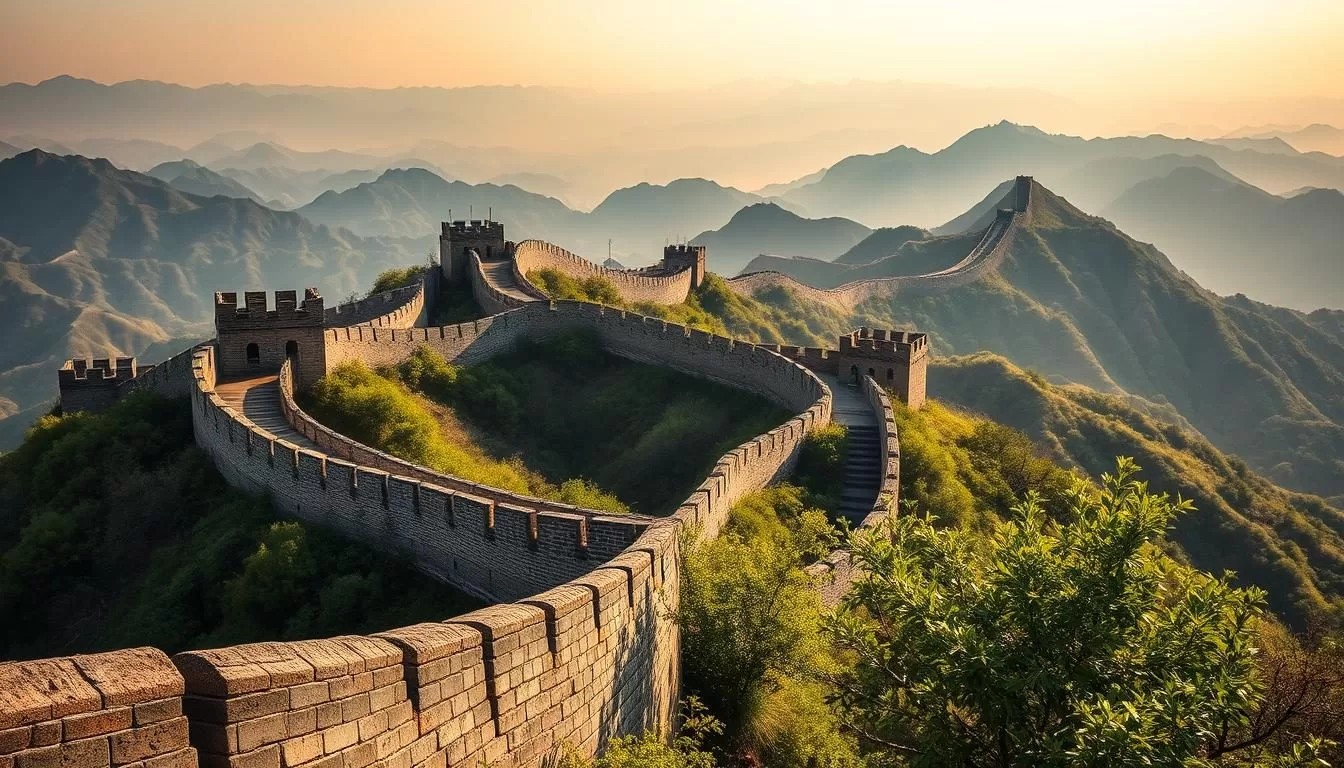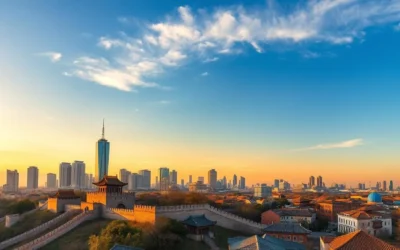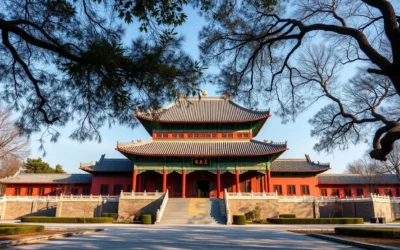✓ Accommodations✓ Flights✓ Rental Cars✓ Tours & Activities
Planning your journey around the right time can make all the difference. Spring and autumn are widely regarded as the most favorable seasons to explore this diverse destination. With mild weather and fewer crowds, these periods offer a perfect balance for sightseeing and outdoor activities.
During spring, temperatures range from 3°C to 23°C, making it ideal for visiting iconic landmarks like the Great Wall. Autumn brings cooler breezes and vibrant foliage, creating a picturesque backdrop for your adventures. These seasons also coincide with local festivals, such as the Chinese New Year, adding cultural richness to your trip.
Whether you’re exploring historic cities or natural landscapes, understanding seasonal trends ensures a smoother experience. This guide will help you choose the perfect time to visit, balancing weather conditions and crowd levels for an unforgettable journey.
Discovering Your Chinese Adventure
Embarking on a journey to explore diverse landscapes and vibrant cultures requires careful planning. This guide is your ultimate companion, offering insights into the best travel periods, regional climates, and cultural highlights. Whether you’re drawn to bustling cities or serene countryside, understanding the nuances of each season ensures a seamless experience.

What to Expect from This Ultimate Guide
This guide covers everything from peak tourist times to off-peak gems. You’ll learn about key differences in weather patterns, crowd levels, and local events. For instance, the Chinese New Year brings vibrant celebrations, while the Harbin Ice Festival transforms northern regions into a winter wonderland.
Each season offers unique opportunities. Spring and autumn are ideal for mild weather and fewer crowds, while summer and winter present their own charms and challenges. This guide helps you navigate these variations, ensuring your itinerary aligns with your preferences.
How to Use This Guide for Planning Your Trip
Start by identifying your priorities. Are you drawn to cultural events, natural beauty, or iconic landmarks? Use this guide to tailor your plans based on travel seasons and regional highlights. For example, early October is perfect for experiencing National Day celebrations, but be prepared for higher accommodation prices.
Pay attention to practical details like weather variations and crowd patterns. This guide integrates seasonal insights with actionable advice, making it easier to craft a personalized adventure. Whether you’re a first-time visitor or a seasoned traveler, these tips will enhance your journey.
Understanding China’s Diverse Climate and Regions
Exploring different regions means adapting to unique weather patterns. The vast territory spans multiple climate zones, from freezing winters in the north to humid summers in the south. Knowing these differences helps you plan the perfect time visit and enjoy each area’s natural beauty.
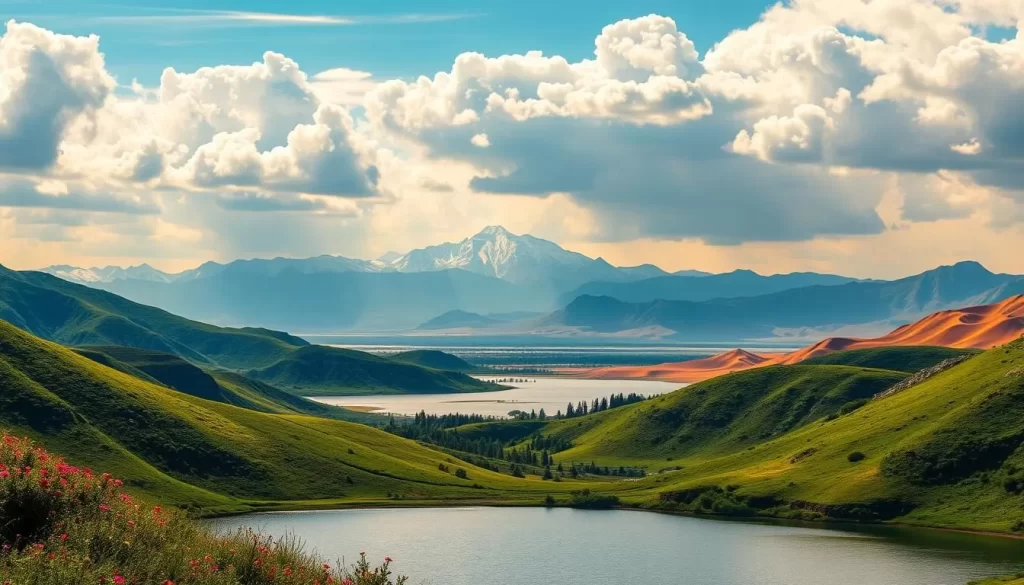
North China: Winters, Summers, and Unique Extremes
North China experiences dramatic seasonal shifts. Winters can be bitterly cold, with temperatures dropping to -20°C in cities like Harbin. Summers, on the other hand, are hot and humid, often reaching 96°F (36°C) in areas like Beijing. These extremes make layering essential for comfort during your day trips.
Tourist hotspots like the Harbin Ice Festival thrive in winter, while summer offers vibrant outdoor activities. However, the intense temperature swings require careful planning to ensure a smooth experience.
South and Central China: Milder Winters and Humid Summers
In contrast, South and Central China enjoy milder winters and hot, humid summers. Cities like Shanghai experience summer humidity levels up to 100%, making lightweight clothing a must. Winters are more temperate, with temperatures ranging from the 30s to 50s°F (0 to 10°C).
This region’s climate is ideal for exploring cultural landmarks and natural wonders. However, the rainy season from June to August can disrupt travel plans. Choosing the right time visit ensures you avoid heavy rainfall and enjoy pleasant weather.
Understanding these regional differences helps you tailor your itinerary. Whether you’re braving the cold in the north or navigating humidity in the south, knowing the climate enhances your journey.
Key Seasonal Trends and Weather Insights
Understanding seasonal trends can transform your travel experience. Each month brings unique weather patterns and crowd levels, influencing your journey. By planning around these trends, you can enjoy a smoother and more enjoyable trip.
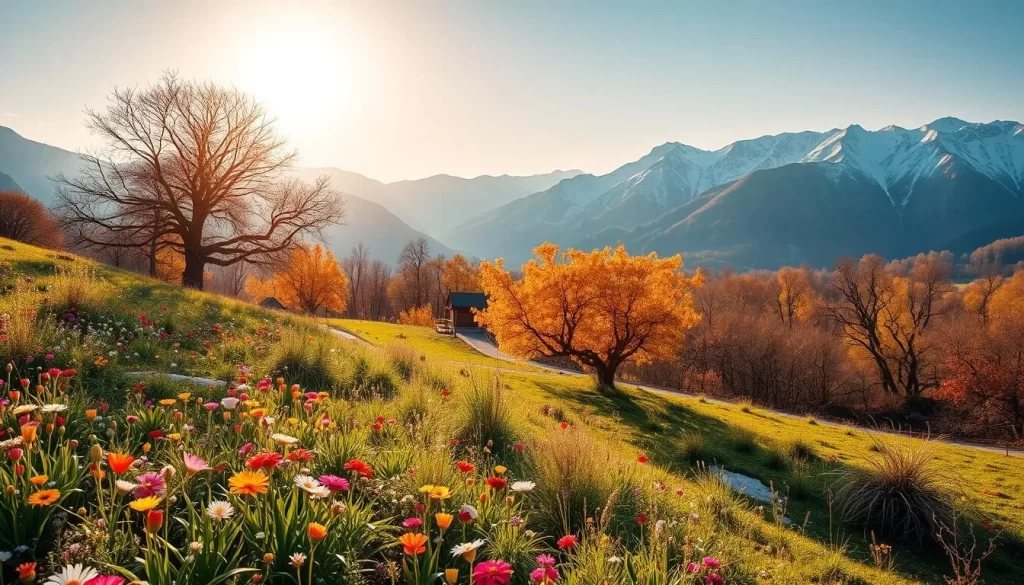
Spring and Autumn: The Ideal Seasons for Travel
Spring and autumn are widely regarded as the best times to explore. During these months, temperatures are mild, ranging from 50°F to 75°F, making outdoor activities comfortable. Crowds are also smaller compared to peak seasons, allowing you to enjoy popular attractions without long waits.
In spring, blooming flowers and festivals add charm to your trip. Autumn, on the other hand, offers vibrant foliage and pleasant breezes. Both seasons are perfect for exploring diverse regions across the country.
Summer and Winter: Challenges and Hidden Gems
Summer brings warm weather but also higher humidity and occasional rain. Temperatures can soar above 90°F in many regions, making sightseeing challenging. However, this season is ideal for coastal escapes and water-based activities.
Winter, while cold, offers unique experiences like snow festivals and fewer crowds. In northern areas, temperatures can drop below freezing, so pack accordingly. Despite the chill, winter reveals hidden gems that are less crowded and equally captivating.
| Season | Weather | Crowd Level | Best Activities |
|---|---|---|---|
| Spring | Mild (50°F-75°F) | Moderate | Festivals, sightseeing |
| Autumn | Cool (55°F-70°F) | Low | Hiking, cultural tours |
| Summer | Hot (80°F-95°F) | High | Beach trips, water sports |
| Winter | Cold (20°F-40°F) | Low | Snow festivals, indoor tours |
By aligning your trip with these seasonal insights, you can maximize your experience and avoid common challenges. Whether you prefer mild weather or unique adventures, there’s a perfect month for every traveler.
When to Visit: China: Best Months for a Weather-Savvy Trip
Choosing the right time for your journey can significantly enhance your experience. Understanding the differences between peak, shoulder, and low travel seasons helps you plan a trip that aligns with your preferences. Each season offers unique benefits, from festive atmospheres to quieter destinations.
Defining Travel Seasons
Peak seasons are the busiest times, often coinciding with major holidays and school breaks. These periods, like the Chinese New Year, bring vibrant celebrations but also larger crowds and higher prices. Shoulder seasons, such as spring and autumn, offer milder weather and fewer tourists, making them the best time for sightseeing.
Low seasons, like winter, are quieter and more affordable. While temperatures can drop, events like the Harbin Ice Festival create unforgettable experiences. Balancing your desire for festive atmospheres with practical weather considerations ensures a smoother trip.
Influence of Holidays and Weather
Popular holidays and events significantly impact travel planning. For example, the holiday season in December attracts many visitors to cities like Hong Kong, known for its festive decorations. Summer, despite the heat, is ideal for coastal escapes and water-based activities.
Understanding these patterns helps you avoid overcrowded destinations and enjoy a more relaxed journey. Whether you prefer mild weather or unique winter festivities, there’s a perfect time for every traveler.
| Season | Characteristics | Best For |
|---|---|---|
| Peak | High crowds, festive events | Cultural celebrations |
| Shoulder | Mild weather, fewer tourists | Sightseeing, outdoor activities |
| Low | Quieter, affordable | Winter festivals, budget travel |
By aligning your trip with these seasonal insights, you can maximize your experience and avoid common challenges. Whether you’re drawn to bustling cities or serene landscapes, understanding travel seasons ensures a memorable adventure.
Unforgettable Festivals and Seasonal Events
Immerse yourself in the vibrant tapestry of cultural celebrations that define the year. These events offer a unique glimpse into traditions that have been cherished for generations. From grand spectacles to intimate gatherings, each festival tells a story of heritage and community.
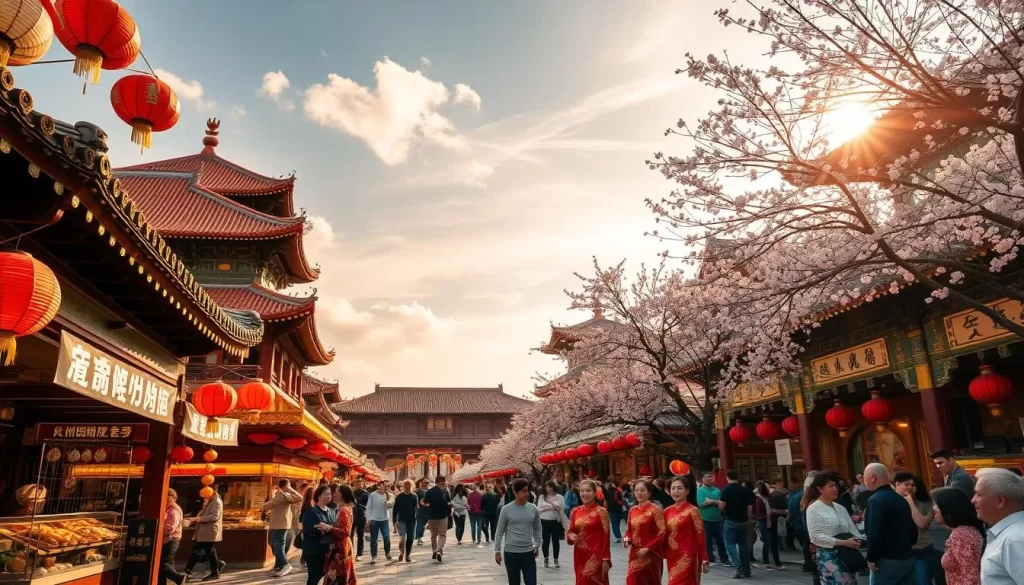
Traditional Celebrations: Chinese New Year and Lantern Festivals
The Chinese New Year is a highlight of the cultural calendar, marked by 15 days of festivities. Families gather to honor traditions, enjoy feasts, and watch dazzling fireworks. The Lantern Festival, which concludes the celebrations, lights up the night with colorful displays and joyful parades.
These events are perfect for family bonding and cultural immersion. However, it’s wise to plan well in advance, as accommodations fill up quickly during this peak season.
Seasonal Highlights: Harbin Ice, Dragon Boat, and Mid-Autumn Festivals
The Harbin Ice Festival transforms the city into a winter wonderland. Massive sculptures made of ice snow create a magical atmosphere, drawing visitors from around the world. For a summer adventure, the Dragon Boat Festival offers thrilling races and the chance to savor traditional zongzi dumplings. Learn more about this event in our .
Autumn brings the Mid-Autumn Festival, a time for mooncakes and lantern-lit evenings. While these events are enchanting, be prepared for occasional rain that can add an unexpected twist to your plans.
Each festival offers a unique way to connect with local culture and create lasting memories. Whether you’re marveling at ice sculptures or racing dragon boats, these celebrations are a must-experience.
Must-See Attractions for Every Season
Discovering the top attractions across different seasons ensures a memorable journey. From iconic landmarks to regional marvels, there’s always a best time visit to enjoy these wonders. Whether you’re drawn to history, culture, or natural beauty, these sites offer something special year-round.
Iconic Sites: The Great Wall, Forbidden City, and More
The Great Wall and Forbidden City are timeless destinations that captivate visitors regardless of the season. Spring and autumn are ideal for exploring these sites, with mild china weather and fewer crowds. In September, Beijing’s average high temperature is 79°F (26°C), making it comfortable for outdoor activities.
Winter transforms these landmarks into serene escapes, offering a unique perspective with fewer tourists. The Forbidden City’s architecture shines under crisp winter skies, while the Great Wall’s snow-covered sections create a magical experience.
Regional Wonders: Xi’an Terracotta Army and Harbin Ice Festival
In Xi’an, the Terracotta Army is a year-round marvel, but autumn’s pleasant weather enhances the experience. September’s air quality is among the best, ensuring clear views and comfortable exploration.
For a winter adventure, the Harbin Ice Festival is a must-see. This event transforms the city into a winter wonderland, with massive ice sculptures and festive activities. Winter temperatures can drop to -16°F (-9°C), so pack accordingly.
| Attraction | Best Season | Weather | Tips |
|---|---|---|---|
| Great Wall | Spring, Autumn | Mild (50°F-75°F) | Visit early to avoid crowds |
| Forbidden City | Spring, Winter | Cool (40°F-70°F) | Winter offers fewer tourists |
| Xi’an Terracotta Army | Autumn | Pleasant (70°F-80°F) | Enjoy clear air quality |
| Harbin Ice Festival | Winter | Cold (below 32°F) | Dress warmly for outdoor activities |
Timing your visit china around these attractions ensures a richer experience. For more insights on planning your trip, explore the ideal times to visit other destinations.
Practical Travel Tips for a Weather-Savvy Journey
Preparing for a trip means being ready for anything, especially when it comes to weather and climate. From packing the right gear to planning your itinerary, these tips will help you navigate diverse conditions with ease.
Packing Essentials and Local Weather Considerations
Packing smart is the first step to a smooth journey. In North China, winters can be harsh, with temperatures dropping below freezing. Layering is key to staying warm, so pack thermal wear, a heavy coat, and insulated boots.
For autumn travels, lightweight clothing and a waterproof jacket are essential. Unexpected rain is common during this season, so always check the forecast before heading out.
Here’s a quick guide to what you’ll need:
| Season | Essentials |
|---|---|
| Winter | Thermal wear, heavy coat, gloves, scarf |
| Autumn | Light layers, waterproof jacket, umbrella |
| Summer | Breathable fabrics, sunscreen, hat |
| Spring | Light jacket, comfortable shoes, sunglasses |
Customizing Your Itinerary Based on Climate
Your itinerary should reflect the weather conditions of your destination. During the Lunar New Year, many cities are bustling with celebrations, but the weather can be unpredictable. Plan indoor activities as a backup.
In North China, winter is perfect for visiting ice festivals, while autumn is ideal for exploring outdoor attractions like the Great Wall. Always check local forecasts to avoid surprises.
“The weather can make or break your trip. Being prepared ensures you enjoy every moment, rain or shine.”
For more tips on staying safe during your travels, check out this guide on .
Navigating Crowds and Peak Travel Times
Timing your visit to popular destinations can make a world of difference in your travel experience. Avoiding peak travel periods ensures you enjoy iconic sites without the stress of long lines and overcrowding. Here’s how to plan smarter and make the most of your journey.
Strategies to Avoid Overcrowded Destinations
One of the best tips for a relaxed experience is to visit major attractions early in the morning. Arriving at the Forbidden City by 7 am allows you to explore its grandeur in relative peace. Similarly, lesser-known entrances can help you bypass long queues and enjoy quicker access.
Traveling during off-peak months, like October to April, can also reduce crowds significantly. Hotel rates are often lower during these periods, giving you more budget flexibility. For events like the Dragon Boat Festival, plan your visit on weekdays to avoid the busiest days.
Here’s a quick guide to help you navigate peak travel times:
| Strategy | Benefit |
|---|---|
| Early morning visits | Fewer crowds, better photo opportunities |
| Off-peak travel | Lower costs, relaxed experience |
| Weekday visits | Avoid weekend rush |
| Lesser-known entrances | Quicker access, less congestion |
Booking accommodations and tickets in advance is another essential tip. This minimizes waiting times and ensures you secure your spot at popular attractions. For more insights on managing crowds, check out this guide on peak vs. off-peak travel.
By following these strategies, you can enjoy a smoother and more enjoyable journey. Whether you’re exploring the Forbidden City or attending the Dragon Boat Festival, timing and planning are key to a stress-free experience.
Conclusion
Every year offers a unique opportunity to explore this diverse destination. Whether you’re drawn to vibrant festivals like the Dragon Boat celebrations or prefer quieter moments, there’s something for everyone. Each week brings new experiences, from cultural events to breathtaking landscapes.
Traveling during different seasons lets you enjoy varied weather and fewer crowds. Spring and autumn are perfect for mild temperatures, while winter offers magical snowscapes. Summer, though warm, is ideal for coastal escapes and outdoor activities.
Use this guide to plan your journey, balancing festive events with serene moments. Discover the rich history, modern marvels, and vibrant culture that await you. Ready to start your adventure? Explore why September is a fantastic time to travel and begin planning your unforgettable trip today.
The above is subject to change.
Check back often to TRAVEL.COM for the latest travel tips and deals.
